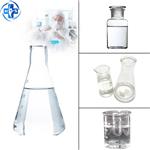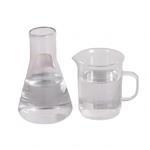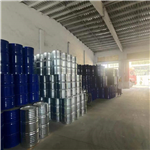- Butyraldehyde
-

- $9.90/ kg
-
2023-09-14
- CAS:123-72-8
- Min. Order: 1kg
- Purity: 99%
- Supply Ability: 5000000kg/Year
- Butyraldehyde
-

- $0.00 / 25KG
-
2023-08-26
- CAS:123-72-8
- Min. Order: 1KG
- Purity: 99%
- Supply Ability: 50000KG/month
- Butyraldehyde
-

- $9.00 / 1KG
-
2023-03-06
- CAS:123-72-8
- Min. Order: 1KG
- Purity: 99.8%
- Supply Ability: 100tons
Related articles - The preparation of butyraldehyde
- Butyraldehyde is a colorless, transparent, flammable liquid with a suffocating aldehyde odor. Slightly soluble in water, misci....
- Apr 20,2022
- Uses of Butanal
- Butyraldehyde, also known as butanal, is an organic compound with the formula CH3(CH2)2CHO. This compound is the aldehyde deri....
- Dec 2,2021
|
| | Butyraldehyde Chemical Properties |
| Melting point | -96 °C | | Boiling point | 75 °C(lit.) | | density | 0.817 | | vapor density | 2.5 (vs air) | | vapor pressure | 90 mm Hg ( 20 °C) | | refractive index | n20/D 1.380(lit.) | | FEMA | 2219 | BUTYRALDEHYDE | | Fp | 12 °F | | storage temp. | 2-8°C | | solubility | water: soluble50g/L at 20°C | | form | Liquid | | color | Clear colorless | | PH | 6-7 (71g/l, H2O, 20℃) | | Odor | Pungent aldehyde; pungent and intense. | | PH Range | 6-7 | | Odor Threshold | 0.00067ppm | | explosive limit | 1.7-11.1%(V) | | Odor Type | chocolate | | Water Solubility | 7.1 g/100 mL (25 ºC) | | Sensitive | Air Sensitive | | JECFA Number | 86 | | Merck | 14,1591 | | BRN | 506061 | | Exposure limits | No exposure limit is set for n-butyraldehyde. | | Dielectric constant | 13.4(26℃) | | Stability: | Stable. Incompatible with oxidizing agents, strong bases, strong reducing agents, strong acids. Highly flammable. | | LogP | 1.3 at 20℃ and pH4.4-4.7 | | Surface tension | 70mN/m at 1g/L and 20℃ | | CAS DataBase Reference | 123-72-8(CAS DataBase Reference) | | NIST Chemistry Reference | Butanal(123-72-8) | | EPA Substance Registry System | Butyraldehyde (123-72-8) |
| | Butyraldehyde Usage And Synthesis |
| Description | Butanal (N-butyraldehyde) is an organic compound which is the aldehyde derivative of butane. It appeases as a clear liquid.
Butyraldehye is used mainly as an intermediate in the production of synthetic resins, rubber vulcanization accelerators, solvents, and plasticizers. It is also an intermediate for the manufacture of pharmaceuticals, crop protection products, pesticides, antioxidants, tanning auxiliaries, and perfumes. Butyraldehyde has a characteristic pungent odor and it is used as a food additive.
| | References | [1] George A. Burdock, Encyclopedia of Food and Color Additives, Volume 1, 2000
[2] Sunggye Lee, Methane and Its Derivatives, 1997
[3] http://www.solvents.basf.com
| | Description | Butyraldehyde (butanal, IUPAC) is a water-white liquid with a pungent aldehyde odor. Butyraldehyde is a dangerous fire risk, with a flammable range of 2.5%–12.5% in air. Boiling point is 168°F (75°C), flash point is 10°F (?12°C), and ignition temperature is 446°F (230°C). It is slightly soluble in water, with a specific gravity of 0.8, which is lighter than water. Vapor density is 0.804, which is lighter than air. In addition to flammability, butyraldehyde is corrosive and causes severe eye and skin burns. It may be harmful if inhaled. The four-digit UN identification number is 1129. The NFPA 704 designation is health 3, flammability 3, and reactivity 2. The primary uses of butyraldehyde are in plastics and rubber and as a solvent. | | Chemical Properties | colourless liquid with a very unpleasant smell | | Chemical Properties | Butyraldehyde has a characteristic pungent odor. | | Chemical Properties | Butyraldehyde is a highly flammable, colorless liquid with a pungent odor. | | Occurrence | Reported found in the essential oils from flowers, fruits, leaves or bark of Monarda fistulosa L., Litsea cubeba,
Bulgarian clary sage, cajeput, Eucalyptus cinerea, E. globules, and others, as well as in apple and strawberry aromas. Also reported
found in fresh apple, pears, carrots, peas, soybean, butter, milk, black tea, roast chicken, peanuts, loganberry, honey, white wine and
hog plums (Spondias mombins L.). | | Uses | n-Butyraldehyde is used to make rubberaccelerators, synthetic resins, and plasticizers;and as a solvent. | | Uses | Butanal is used in the manufacture of rubber accelerators,
synthetic resins, solvents, and plasticizers. n-Butyraldehyde is
used as an intermediate in the manufacturing of plasticizers,
alcohols, solvents, and polymers (such as 2-ethylhexanol,
n-butanol, trimethylolpropane, n-butyric acid, polyvinyl butyral,
and methyl amyl ketone). It is also used as an intermediate
to make pharmaceuticals, agrochemicals, antioxidants, rubber
accelerators, textile auxiliaries, perfumery, and flavors. It has no
therapeutic use at the present time. | | Uses | 1. Butyraldehyde is an important intermediate. n-Butanol can be prepared by hydrogenation of n-butyraldehyde; 2-ethylhexanol can be prepared by condensation dehydration and then hydrogenation, and n-butanol and 2-ethylhexanol are the main raw materials of plasticizer. Oxidation of n-butyraldehyde can produce n-butyric acid; condensation with formaldehyde can produce trimethylolpropane, which is a plasticizer for synthesizing alkyd resin and raw material for air drying oil; condensation with phenol to produce oil-soluble resin; and urea Condensation can produce alcohol-soluble resin; the products condensed with polyvinyl alcohol; butylamine; The condensate is used as celluloid; resin; solvent for rubber and pharmaceutical products; pharmaceutical industry is used to make "Mianertong"; "pyrimethamine"; methamphetamine, etc. Plasticizers, synthetic resins, rubber accelerators, pesticides and other important intermediate raw materials.
2. Butyraldehyde is an important chemical raw material. It is also used in the preparation of flavors and fragrances. It is contained in various essential oils such as flowers, leaves, fruits, grasses, dairy products, and alcohol in nature. [Food additive usage limit (mg/kg): soft drink 0.71; cold drink 4.8; Candy 2.9; baked goods 5.4; alcohol 0.50; sugar 0.25. ]. It is usually diluted before adding the essence, which has a certain effect on coordinating and increasing the elegance of the top fragrance.
3. Can be used as anesthetic and stimulant. | | Uses | Chiefly in the manufacture of rubber accelerators, synthetic resins, solvents, plasticizers. | | Definition | ChEBI: A member of the class of butanals that consists of propane bearing a formyl substituent at the 1-position. The parent of the class of butanals. | | Preparation | By dry distillation of calcium butyrate and calcium formate. | | Aroma threshold values | Detection: 19 to 37 ppb; recognition: 11 to 27 ppb | | Taste threshold values | Taste characteristics at 5 ppm: musty, fusel, fermented, bready and yeasty with a malty nuance. | | General Description | A clear liquid with a pungent odor. Flash point 20°F. Boiling point 75.7°F (Hawley's). Less dense than water and insoluble in water. Vapors heavier than air. | | Air & Water Reactions | Highly flammable. Insoluble in water. | | Reactivity Profile | A colorless liquid, Butyraldehyde can react with oxidizing materials. In contact with strong acids or bases Butyraldehyde will undergo an exothermic condensation reaction. The dry aldehyde may undergo some polymerization reaction. Reacts vigorously with chlorosulfonic acid, nitric acid, sulfuric acid (oleum). [Sax, 9th ed., 1996, p. 607]. | | Hazard | Flammable, dangerous fire risk. | | Health Hazard | Inhalation will cause irritation and possibly nausea, vomiting, headache, and loss of consciousness. Contact with eyes causes burns. Skin contact may be irritating. | | Health Hazard | n-Butyraldehyde is a mild skin and eye irritant.The liquid in 100% pure form producedmoderate irritation on guinea pig skin. Theirritation resulting from 20 mg in 24 hours on rabbit eye was moderate. A higher dosecould produce severe irritation.
Toxicity of n-butyraldehyde is very low.The effect is primarily narcotic. No toxiceffect, however, was observed in mice from 2-hour exposure at a concentration of 44.6 g/m3.At a higher concentration, 174 g/m3 for30 minutes, it exhibited a general anestheticeffect on rats. Subcutaneous administrationof a high dose, >3 g/kg, produced the sameeffect, affecting the kidney and bladder. | | Fire Hazard | Behavior in Fire: Vapors are heavier than air and may travel considerable distance to a source of ignition and flash back. Fires are difficult to control due to ease of reignition. | | Chemical Reactivity | Reactivity with Water No reaction; Reactivity with Common Materials: No reactions; Stability During Transport: Stable; Neutralizing Agents for Acids and Caustics: Not pertinent; Polymerization: May occur in the presence of heat, acids or alkalis; Inhibitor of Polymerization: Not pertinent. | | Biochem/physiol Actions | Taste at 10 ppm | | Safety Profile | Moderately toxic by
ingestion, inhalation, skin contact,
intraperitoneal, and subcutaneous routes.
Severe skin and eye irritant. Human
immunologcal effects by inhalation: delayed
hypersensitivity. See also ALDEHYDES.
Highly flammable liquid. To fight fire, use
foam, CO2, dry chemical. Incompatible with
oxidzing materials. Reacts vigorously with
chlorosulfonic acid, HNO3, oleum, H2SO4.
When heated to decomposition it emits
acrid smoke and fumes | | Potential Exposure | Mutagen,Human Data; Primary Irritant. Used in making syntheticresins, solvents, and plasticizers | | First aid | If this chemical gets into the eyes, remove anycontact lenses at once and irrigate immediately for at least15 min, occasionally lifting upper and lower lids. Seek medical attention immediately. If this chemical contacts theskin, remove contaminated clothing and wash immediatelywith soap and water. Seek medical attention immediately. Ifthis chemical has been inhaled, remove from exposure,begin rescue breathing (using universal precautions, including resuscitation mask) if breathing has stopped and CPR ifheart action has stopped. Transfer promptly to a medicalfacility. When this chemical has been swallowed, get medical attention. Give large quantities of water and inducevomiting. Do not make an unconscious person vomit.Medical observation is recommended for 24�48 h afterbreathing overexposure, as pulmonary edema may bedelayed. As first aid for pulmonary edema, a doctor orauthorized paramedic may consider administering a corticosteroid spray | | Carcinogenicity | Although butyraldehyde interacts
with DNA, no experimental studies of its carcinogenic
potency were found. | | Environmental Fate | Butanal does not possess high acute toxicity but is a potent
irritant of the skin, eyes, and upper respiratory tract. The
mechanism of toxicity probably involves direct reaction
between the active aldehyde group and cellular components. | | storage | Color Code—Red: Flammability Hazard: Store ina flammable liquid storage area or approved cabinet awayfrom ignition sources and corrosive and reactive materials.Protect against physical damage. Before entering confinedspace where this chemical may be present, check to makesure that an explosive concentration does not exist. Outsideor detached storage is preferred. Prior to working withButyraldehyde you should be trained on its proper handlingand storage. Store in tightly closed containers in a cool,well-ventilated area away from incompatible materialslisted above. Metal containers involving the transfer of thischemical should be grounded and bonded. Drums must beequipped with self-closing valves, pressure vacuum bungs,and flame arresters. Use only nonsparking tools and equipment, especially when opening and closing containers ofthis chemical. Sources of ignition, such as smoking andopen flames, are prohibited where this chemical is used,handled, or stored in a manner that could create a potentialfire or explosion hazard. | | Shipping | UN1129 Butyraldehyde, Hazard Class: 3;
Labels: 3—Flammable liquid | | Toxicity evaluation | The primary degradation process in soil is expected to
be biodegradation. A number of biological screening
studies have demonstrated that butyraldehyde is readily
biodegradable.
The major environmental fate processes for butyraldehyde in
water are biodegradation and volatilization. A number of
biological screening studies have demonstrated that butyraldehyde
is readily biodegradable. Volatilization half-lives of 9 h
and 4.1 days have been estimated for a model river (1-m deep)
and a model pond, respectively. Aquatic hydrolysis, adsorption
to sediment, and bioconcentration are not expected to be
important fate processes. | | Incompatibilities | May form explosive mixture with air.
Butyraldehyde can presumably form explosive peroxides,
and may polymerize due to heat or contact with acids or
alkalis. Incompatible with oxidizers (chlorates, nitrates, peroxides, permanganates, perchlorates, chlorine, bromine,
fluorine, etc.); contact may cause fires or explosions. Keep
away from alkaline materials, strong bases, strong acids,
oxoacids, epoxides, caustics, ammonia, aliphatic amines;
alkanolamines, aromatic amines. May accumulate static
electrical charges, and may cause ignition of its vapors.
Possible self-reaction in air; undergoes rapid oxidation to | | Waste Disposal | Dissolve or mix the material
with a combustible solvent and burn in a chemical incinerator equipped with an afterburner and scrubber. All federal,
state, and local environmental regulations must be
observed. |
| | Butyraldehyde Preparation Products And Raw materials |
|